

The model below depicts a cross-sectional view an explosively erupting volcano, typical of a so-called Plinian eruption. A variety of pressure surfaces exist within the magma column beneath the erupting volcano, and within the eruption column above the volcano. The section below describes the nature of these pressure surfaces and explains the dynamic processes associated with the eruption model. To view a QuickTime movie of this eruption, click movie. To view a 3D flyby beneath the eruption plume of the volcano, click flyby.
 |
| Cross-sectional model of a Plinian Eruption, generated by Jeff Sale and Vic Camp. The model is described below. Click image to view a QuickTime movie of the eruption. |
THE MAGMA COLUMN -- Eruptions are fed from a magma column that exists below the point source of the eruption. The magma column contains two critical pressure surfaces:
|
(1) The exsolution surface occurs in the magma reservoir beneath the volcano. It separates a zone of magma containing dissolved volatiles from an overlying zone of magma containing exsolved gas bubbles (2) The fragmentation surface occurs at the top of the magma column. It separates the zone of magma containing exsolved gas from the overlying eruption column. Fragmentation of the magma is generated by rapid gas expansion and bubble explosion. |
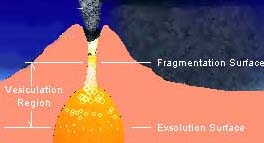 The exsolution of gas from magma
(or "boiling") is called vesiculation. These gas bubbles (vesicles)
begin to form at the exsolution surface. Vesiculation is promoted
by decompression of magma as it rises upward (where the confining
pressure is less than the dissolved gas pressure). Fragmentation
of the bubble walls then begins at the fragmentation surface;
here, the gas bubbles grow during ascent until they become unstable
and explode. This occurs when the volume of bubbles is about 75%
of the total volume of the magma column. Gas release is confined
to the diameter of the magma column, and the eruption velocity
is controlled mainly by the gas content. The low strength of surface
rocks and the high initial exit pressure commonly results in vent
erosion, so that a flared vent shape develops which enhances velocity.
This marks an upward transition from subsonic to supersonic
flow.
The exsolution of gas from magma
(or "boiling") is called vesiculation. These gas bubbles (vesicles)
begin to form at the exsolution surface. Vesiculation is promoted
by decompression of magma as it rises upward (where the confining
pressure is less than the dissolved gas pressure). Fragmentation
of the bubble walls then begins at the fragmentation surface;
here, the gas bubbles grow during ascent until they become unstable
and explode. This occurs when the volume of bubbles is about 75%
of the total volume of the magma column. Gas release is confined
to the diameter of the magma column, and the eruption velocity
is controlled mainly by the gas content. The low strength of surface
rocks and the high initial exit pressure commonly results in vent
erosion, so that a flared vent shape develops which enhances velocity.
This marks an upward transition from subsonic to supersonic
flow.
THE ERUPTION COLUMN --The fragmentation surface is the point source of the eruption. The region of hot gas and broken pyroclastic particles above the fragmentation surface is called the eruption column. It transports pyroclastic materials from the ground into the atmosphere. Common observed heights for plinian eruptive columns are between 2 and 45 km. The eruption column for the 1994 eruption of the Klyuchevskoi volcano in Kamchatka is shown here.
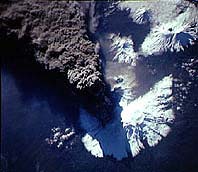 |
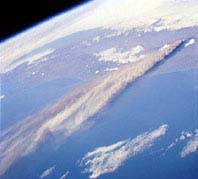 |
|
Klyuchevskoi eruption plume |
Klyuchevskoi eruption |
The physical and mechanical behavior of the erupting column changes as it rises from the the fragmentation surface into the stratosphere. These progressive behavioral changes allow the eruption column to be subdivided into three regions:
|
(1) the gas thrust region in the lower column, driven by gas expansion, (2) the convective thrust region in the upper column, driven by the constant release of thermal energy from internal ash, and (3) the umbrella region at the top of the eruption column. The umbrella region is also known as the "downwind plume". |
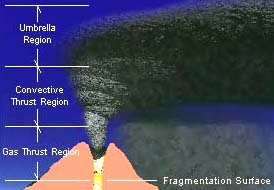 The gas thrust
region is a region of vertical movement of gas and
plastic magma particles that is internally powered by gas expansion
(decompression) at the base of the eruptive column. Its overall
density depends on the particle-to-gas ratio. Initially, the gas
thrust is denser than air because of its incorporation of pyroclastic
particles. However, as these particles fall out (as ballistics),
the density is reduced so that the hot gases in the column are
now less than that of the atmosphere. At this point, the gas thrust
gives way to convective uprise and development of the convective
thrust region, which comprises about 90% of the eruptive
column. The convective plume is driven by the constant release
of thermal energy from internal ash. At some point, the bulk density
of the column will become equal to that of the atmosphere, so
that its upward mobility is only controlled by its momentum. The
column thus spreads out in the umbrella region.
The bottom of umbrella region is where densities of the plume
and the surrounding air are equal. Continued upward mobility towards
the top of the umbrella region is controlled by momentum. The
umbrella region is often asymmetric due to the effect of high
atmospheric winds in the stratosphere.
The gas thrust
region is a region of vertical movement of gas and
plastic magma particles that is internally powered by gas expansion
(decompression) at the base of the eruptive column. Its overall
density depends on the particle-to-gas ratio. Initially, the gas
thrust is denser than air because of its incorporation of pyroclastic
particles. However, as these particles fall out (as ballistics),
the density is reduced so that the hot gases in the column are
now less than that of the atmosphere. At this point, the gas thrust
gives way to convective uprise and development of the convective
thrust region, which comprises about 90% of the eruptive
column. The convective plume is driven by the constant release
of thermal energy from internal ash. At some point, the bulk density
of the column will become equal to that of the atmosphere, so
that its upward mobility is only controlled by its momentum. The
column thus spreads out in the umbrella region.
The bottom of umbrella region is where densities of the plume
and the surrounding air are equal. Continued upward mobility towards
the top of the umbrella region is controlled by momentum. The
umbrella region is often asymmetric due to the effect of high
atmospheric winds in the stratosphere.
For more information on the relationship of eruption types, column height, and explosiveness, see Eruption Column vs. Explosiveness
Dr. Ken Wohletz at the Los Alamos National Laboratory has created a magnificent computer program which allows the user to construct a diverse group of volcanic landforms through the simulation of variable types of eruptions. The parameters of each eruption type can be set independently. The eruption software can be downloaded free by clicking Erupt 2.5. A commercial version (Erupt 3.0) will soon be available from RockWare.
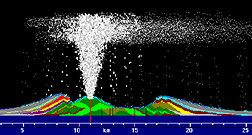 |
|
development, created by Erupt 2.5 |